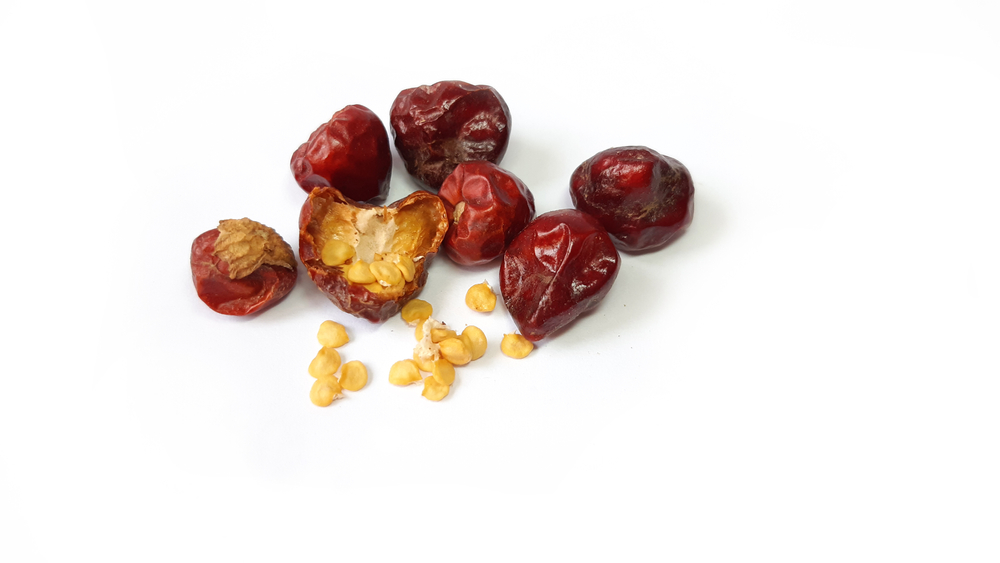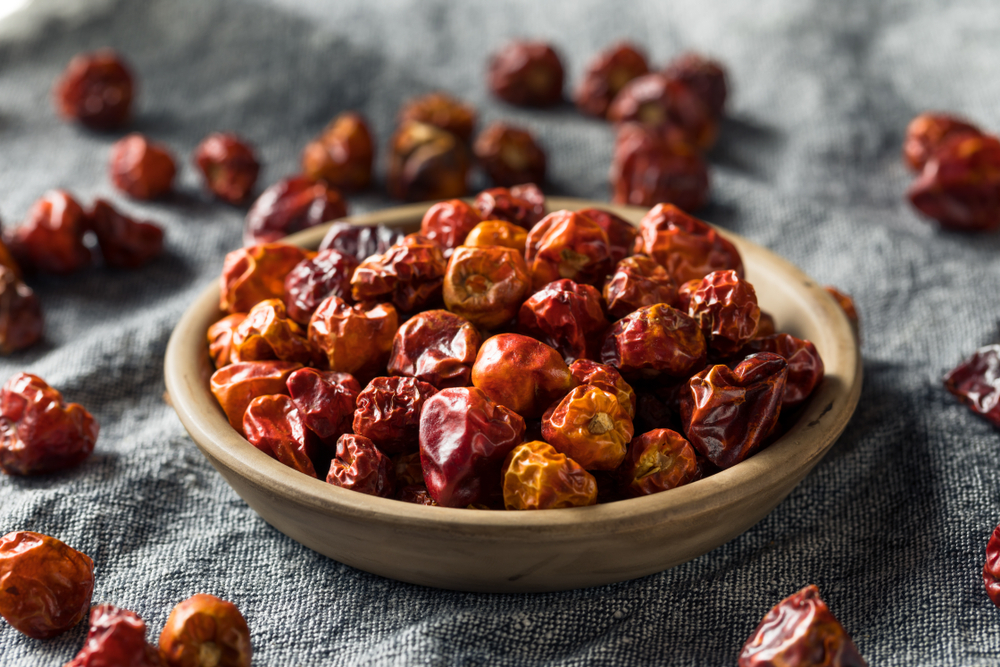A dundicut pepper is a small, medium-heat chili pepper traditionally dried and used in Pakistani, Indian, and Middle Eastern cuisines. Despite the small size, these peppers pack a real heat punch at 30,000-65,000 SHUs, in line with cayenne peppers and chile de arbol.
What Are Dundicut Peppers?
Dundicut peppers are hot peppers from the capsicum annum species. These small fiery chiles are native to Pakistan.
Dundicut peppers possess a high heat level. A small amount can magically give dishes both flavor and spiciness. For centuries, these chiles have been a primary ingredient in traditional Pakistani, Asian and middle-eastern cuisines.
Pakistanis still farm this indigenous red chili commercially to date. Other areas, including Sikkim town in north-east India and the eastern Nepalese municipality of llam are also known for dundicut pepper growing.
Dundicut peppers are best used in their dried form to spice stews, soups, sauces, and other favorite dishes.
Origin
Dundicut hot chiles came from a small, north Pakistani city called Lahore in the 1990s. The locals of Kunri town, Sindh province, started growing them on a large scale, and today, the region hosts the largest chili market in Pakistan.
While other countries like the U.S. are embracing dundicut farming, Pakistan, India, and Nepal remain the primary growers and consumers.
Dundicut chiles are famous and often lovingly described as ‘the national pepper of Pakistan.’ No traditional Pakistani dish is complete without dundicut peppers.
Other Names
Chile dundicut also goes by the Asian name ‘Gol Lal Mirch.’ Gol translates to ‘home’ in English, while ‘Lal Mirch` refers to ‘red chili.’
Color
Like most capsicum annuum, young dundicuts are light green, whereas full-mature, ripe chiles present a vibrant, deep, red color. Proper drying ensures the peppers retain the bright colors essential for coloring dishes.
Appearance
These peppers have a similar look to the scotch bonnet peppers. They are bulbous with an appearance mimicking a tiny bonnet.
Taste
Dundicut peppers have an intense, complex flavor. They are slightly sweet, fruity, and bitter, with an additional floral aroma.
Texture
Fresh dundicut peppers are smooth and shiny. However, in their most popular form, dried dundicuts have a wrinkled, raisin-like texture.
Size
Don’t let the small compact size deceive you. Dundicut peppers are tiny, measuring .5-1 inch in diameter. The mature pepper plants grow up to 1-2 feet tall.
Shape
A dundicut pepper has a round, spherical shape and a pointy end, making it look like teardrops. On drying, they adopt a raisiny, berry-like appearance.

How Hot Are Dundicut Peppers?
With a range of 30,000-65,000 SHUs on the Scoville scale, Dundicut chiles are the hottest peppers in Pakistan. The Pakistani chili is 6-26 times spicier than a jalapeno.
Cayenne peppers (30,000- 50,000 SHUs) have a slightly lower heat rating than dundicuts. The hottest chile de arbol has the same spiciness as a mild dundicut pepper, whereas its look-alike – scotch bonnet chile (100, 000-350,000 Scoville heat units) — harbors nearly 4-6 times more heat than dundicuts.
How To Use Dundicut peppers
Dundicut peppers are mostly dried and crushed into powder for use in various recipes. If you want full-bodied flavors, rehydrate the dry chiles in hot water and puree them like you would other Mexican dried chili peppers.
Some creative uses of dundicut chiles are as follows:
- Soups – Chile dundicut gives authentic soups a spicy, fruity flavor.
- Chutneys – Rehydrate dried Dundicut chiles and use them instead of red hot chili peppers to spice your mango chutney.
- Pre-grilling marinades – Use these Pakistani red peppers for marinating beef, pork, and seafood before grilling.
- Hot sauces – Dundicut hot peppers give hot sauces a serious heat upgrade.
- Stews – Add Dundicut chili powder to authentic beef, mutton, or chicken stews for a flavorful dish.
- Curries and masala for meats – These small, fiery peppers taste supreme in curries and traditional kharra masala with fish.
Are Dundicut Peppers Related To Habaneros Or Scotch Bonnets?
Dundicuts, habaneros, and scotch bonnets have shared similarities but are entirely different peppers.
- Taste: Scotch bonnets, habaneros, and dundicut chiles have sweet, floral, and fruity flavors. However, habaneros have deeper undertones.
- SHU: Habanero and scotch bonnet are extremely hot chiles. They have a range of 100,000-350,000 Scoville heat units, whereas dundicuts possess 30,000-65,000 SHUs.
- Species: Both scotch bonnet and habanero peppers belong to the capsicum chinense species, while dundicut is a capsicum annuum variety.
- Origin: Habanero and scotch bonnet have roots in the Amazon basin. The two are natives of Mexico, while dundicut chiles come from Pakistan.
Where To Buy Dundicut Peppers
You can easily buy dried Dundicut chiles from specialty stores near you or the web.
If you have a green thumb, buy Dundicut pepper seeds or plants from Amazon and grow them in your garden.
Substitutes For Dundicuts
Malagueta (60,000-100,000 SHUs) and chiltepin (50,000-100,000shu) peppers have a fruity, sweet-bitter, peppery taste similar to dundicut chili peppers.
Their lower end is closer to that of dundicut chiles, so you may have to adjust the amount you use.
Aji limo chile pepper (30,000-50,000 SHUs) is another excellent substitute based on its heat level and flavor profile. Pequin chile (30,000-60,000 Scoville units ) best fits Dundicut’s spice and fruity taste.
Can You Grow Dundicut Peppers?
You don’t need a spacious area for growing dundicut peppers as they thrive well in containers, pots, or small home gardens.
While you can grow directly in your garden soil, it’s best to start by planting your pepper seeds indoors. Choose a sunny spot by your window sill to ensure seed germinating occurs.
Dundicut peppers love rich, well-drained soils. Before transplanting to containers or a home garden, prepare the ground and enrich it with compost manure.
Wait to move your pepper plants until temperatures three inches below the soil surface reach 60 degrees Fahrenheit. If using containers, choose wide, 5-gallon ones to give roots space for spreading.
Your dundicut peppers take 80 days from planting to harvesting. On harvesting, use a waxed dental floss string to dry the peppers since other thread types quickly dissolve due to capsaicin oil.

